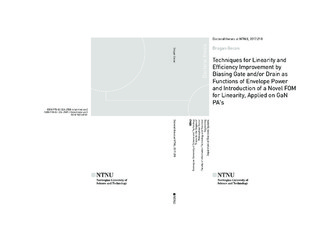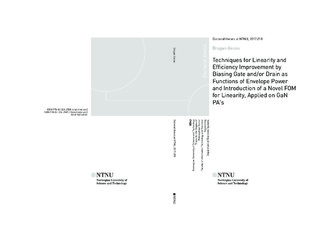| dc.contributor.advisor | Olavsbråten, Morten | |
| dc.contributor.author | Gecan, Dragan | |
| dc.date.accessioned | 2017-09-06T09:34:03Z | |
| dc.date.available | 2017-09-06T09:34:03Z | |
| dc.date.issued | 2017 | |
| dc.identifier.isbn | 978-82-326-2509-3 | |
| dc.identifier.issn | 1503-8181 | |
| dc.identifier.uri | http://hdl.handle.net/11250/2453328 | |
| dc.description.abstract | Over the past years, a digital cellular system evolved from the GSM providing the voice and text services over the GPRS and EDGE to the 3G and 4G services providing the video and broadband mobile services, and it is now moving forward to the 5G. Consequently, the demand for the wireless data has been dramatically increasing which has led to the development of the more spectral efficient modulation with the increased peak-to-average power ratio (PAPR).
In order to maintain the original information carried by the RF signal, the RF power amplifiers (PAs) have to assure the linear amplification. Traditionally, the class A PA has been used to satisfy the high linearity requirement. Unfortunately, modern modulation schemes with the high PAPR force the class A PA to operate well in back-off to avoid nonlinear amplification of the high signal peaks. This leads to the extremely poor average efficiency and the efficiency decays rapidly as the envelope of the signal decreases. This linearity-efficiency trade-off challenges the PA designers to develop various efficiency and linearity enhancement techniques to satisfy the linearity requirements with as high as possible efficiency.
This dissertation investigates linearization capabilities of a dynamic gate bias technique applied to a 10 W GaN HEMT PA and introduces a Power Gate Tracking (PGT) technique for the PA linearization. It is important to find an optimal matching networks for the PA operating under the dynamic gate bias conditions, so the 10 W GaN HEMT load sensitivity is investigated. Furthermore, a new linearity measure and figure of merit (FOM) is developed, which evaluates the nonlinear distortion both inside and outside of the output signal bandwidth, making it convenient for the linearity evaluation and optimisation. This dissertation also shows that the bandwidth of the dynamic bias or supply voltage can be limited and well defined if the power of the signal is used instead of its envelope like in an envelope tracking (ET) technique. Based on the power tracking principle, a Power Envelope Tracking (PET), 2nd order Power Envelope Tracking (2nd order PET) and an Auxiliary Power Tracking (APT) techniques for dynamic drain supply operation are also presented. In addition, the PET and the 2nd order PET techniques are combined with the PGT technique in order to improve linearity.
A load-pull measurement of the 10 W GaN HEMT shows that the fundamental load for the maximum output power and the maximum efficiency does not change much with varying the gate bias voltage. There is also an overlapping impedance area for the second and third harmonics tuned for the maximum power added efficiency (PAE). The PA subjected to the dynamic gate bias operation is designed with the selected optimal matching impedances from the load-pull results. The results are showing the improvement of the PA linearity performance if the transfer phase is flattened with the PGT technique while flattening the gain does not provide any linearity improvement. The PET technique results in the simultaneous linearity and efficiency improvement compared to the reference static bias PA with further improvement in the linearity if it is combined with the PGT technique optimised for the presented FOM. The 2nd order PET technique used for the approximation of the ET tracking function shows the comparable efficiency enhancement as the ET technique but with the significantly narrower and well defined drain supply voltage bandwidth. The APT technique shows slightly higher linearity improvement capabilities compared to the auxiliary envelope tracking (AET) technique with significantly narrower drain supply voltage bandwidth due to the power tracking. If the APT technique works in combination with the PGT technique the dynamically biased PA shows further improvement in the linearity performance. | nb_NO |
| dc.language.iso | eng | nb_NO |
| dc.publisher | NTNU | nb_NO |
| dc.relation.ispartofseries | Doctoral theses at NTNU;2017:218 | |
| dc.relation.haspart | Paper 1:
Gecan, Dragan; Olavsbråten, Morten; Gjertsen, Karl Martin.
Investigation of the Practical Output Load Impedance Sensitivity of a 10 W GaN Device Subjected to Gate Bias Variation -
Is not included due to copyright available at
http://dx.doi.org/10.1109/PAWR.2016.7440160 | |
| dc.relation.haspart | Paper 2:
Gecan, Dragan; Olavsbråten, Morten; Gjertsen, Karl Martin.
Investigation of Linearity Improvement with Dynamic Gate Bias Technique for Flat Gain or Phase of an 10 W GaN HEMT Power Amplifier - 2016 IEEE/ACES
- Is not included due to copyright available at
http://dx.doi.org/10.1109/ROPACES.2016.7465391 | |
| dc.relation.haspart | Paper 3:
Gecan, Dragan; Olavsbråten, Morten; Gjertsen, Karl M..
Comprehensive Investigation of a Dynamic Gate Biasing Technique for Linearity Improvement Based on Measurement of a 10 W GaN HEMT Power Amplifier. 24th Telecommunications forum TELFOR 2016
- Is not included due to copyright available at
http://dx.doi.org/10.1109/TELFOR.2016.7818775 | |
| dc.relation.haspart | Paper 4:
Gecan, Dragan; Olavsbråten, Morten; Gjertsen, Karl Martin.
Measured linearity improvement of 10 W GaN HEMT PA with dynamic gate biasing technique for flat transfer phase. IEEE MTT-S International Microwave Symposium Digest 2016
- Is not included due to copyright available at
http:dx.doi.org/10.1109/MWSYM.2016.7540309 | |
| dc.relation.haspart | Paper 5:
Gecan, Dragan; Gjertsen, Karl Martin; Olavsbråten, Morten.
Novel metric describing total nonlinearity of Power amplifier with a corresponding figure of merit for linearity evaluation and optimization. IEEE Microwave and Wireless Components Letters 2016 ;Volum 27.(1) s. 85-87
- Is not included due to copyright available at
http://dx.doi.org/10.1109/LMWC.2016.2629980 | |
| dc.relation.haspart | Paper 6:
Gecan, Dragan; Olavsbråten, Morten; Gjertsen, Karl M..
Investigation of the Gate Bias Voltage Influence on Linearity Performance of the ET and AET 10 W GaN HEMT PAs. 24th Telecommunications forum TELFOR; 2016
- Is not included due to copyright available at
http://dx.doi.org/10.1109/TELFOR.2016.7818758 | |
| dc.relation.haspart | Paper 7:
Gecan, Dragan; Olavsbråten, Morten; Gjertsen, Karl Martin.
Auxiliary Power Tracking Technique for Linearity Improvement of a 10 W GaN HEMT PA with and without Power Gate Tracking. PAWR 2017
- Is not included due to copyright available at
http://dx.doi.org/10.1109/PAWR.2017.7875577 | |
| dc.title | Techniques for Linearity and Efficiency Improvement by Biasing Gate and/or Drain as Functions of Envelope Power and Introduction of a Novel FOM for Linearity, Applied on GaN PA's | nb_NO |
| dc.type | Doctoral thesis | nb_NO |
| dc.subject.nsi | VDP::Technology: 500::Electrotechnical disciplines: 540 | nb_NO |
| dc.description.localcode | Digital fulltext not available | nb_NO |

